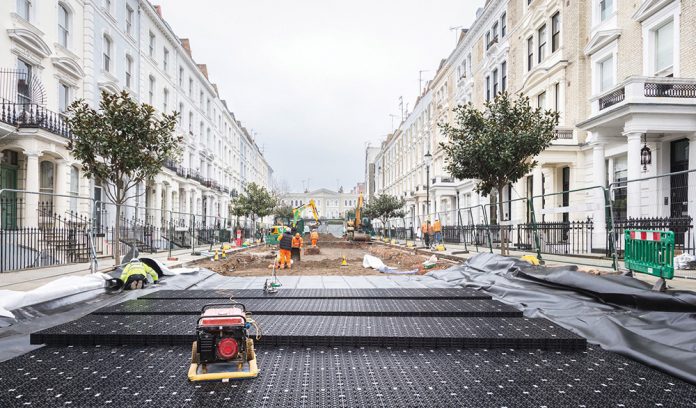Over 12 months on from the introduction of the new Sewerage Sector Guidance (SSG), Jon Stewart, Business Development Director for Drainage at Polypipe Civils & Green Urbanisation, explains why now is the time for the industry to prioritise the next generation of sustainable drainage solutions (SuDS).
Thanks to the changes brought in by SSG, water and sewerage companies are now able to adopt a wider range of sewer types, including those that go way beyond traditional SuDS to benefit individuals, communities and the environment. The guidance has broadened options to enable more creative, holistic sewer design as part of green urbanisation – looking at how water can be managed to fuel green assets and prevent future flooding – key to meeting the country’s biodiversity agenda and help tackle the impact of climate change. However, optimal outcomes can only be achieved through proactive collaboration and by including water management solution manufacturers to share their knowledge at the very earliest planning stages.
A bespoke approach to individual networks
Striking a perfect balance between the needs of water companies, planning authorities and developers can make upgrading or adding to sewer networks a complex process. Developers are increasingly encouraged to integrate tree pits, raingardens, swales, blue/green roofs and retention ponds into their site plans to meet the biodiversity targets of local authority planning teams. But until this becomes the norm, water companies may have uncertainties about how such installations affect water flows throughout their catchment areas.
Every sewer network scheme is different and requires a tailored design and specification to ensure the most suitable solutions are in place above and below ground to meet both regional and national requirements. But whatever is selected must equally satisfy both developers looking to create cost effective schemes that meet government criteria, and water authorities that need the developments to have a positive impact on the performance of their sewer network.
As such, there is a responsibility on drainage system manufacturers to create solutions that can be seamlessly plugged into residential, commercial and urban realm developments to improve the management of how much water is entering a sewer network at any given time, while optimising the use of the rainfall captured through reuse to support natural landscapes such as amenity spaces, pocket parks and active travel green corridors.
To achieve this, breakthrough stormwater attenuation and re-use technologies, which have given rise to a new generation of enhanced, net-zero sustainable drainage solutions, offer a creative way forward. Key to achieving optimal outcomes is choosing manufacturers that develop holistic water management and green urbanisation solutions, engaging them in the development designs at the very outset of sewer network upgrade plans, or on developments which will go on to have a direct impact on adopted sewer systems.
A one-stop-shop of next generation solutions
At Polypipe Civils & Green Urbanisation, this means offering a one-stop-shop for design, installation and optimisation of next generation sustainable water management solutions that complement existing sewer networks, and which deliver a wide range of additional multi-functional benefits. Our role is to inspire developers with solutions that not only meet planning conditions and are simple to install, but also help them deliver schemes that are futureproofed against climate change and support a greener future. Simultaneously, we want to encourage water companies to see integrated surface water managed green assets as the new norm, ensuring sewer networks are adaptive and resilient, protecting against the risk of floods and encouraging biodiversity to flourish. Additionally, we can ensure individual drainage and green assets can be maintained exactly as required – pipes must be cared for differently to a tree pit or raingarden, so designs have to ensure this can be achieved efficiently while at the same time delivering consistent, optimal performance.
Dialogue must increase – particularly in the early planning stages – between water management solution manufacturers and contractors, planners, water authorities and local authorities. A collaborative way of working will ensure that adoptable and non-adoptable assets are working in tandem, in line with SSG, but also to the benefit of the communities they serve. Any existing or future development can be overlayed with adaptive drainage solutions which reduce burden on both developer and water companies by putting green urbanisation experts central to delivery and maintenance. Doing so will bring better engineering capabilities to the fore, enabling the new generation of sewer networks to contribute more directly to the environments we all aspire to live in.
www.polypipe.com/watershed



